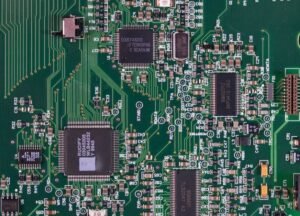Neural Network Explained Simply
In today’s technology-driven world, neural networks have become integral to various industries such as finance, healthcare, and automation. This article aims to provide a simple explanation of what neural networks are and how they work, without overwhelming you with technical jargon.
Key Takeaways
- Neural networks are a type of artificial intelligence that can mimic the human brain.
- They consist of interconnected nodes (artificial neurons) organized in layers.
- Neural networks are trained using large datasets to recognize patterns and make accurate predictions.
- Deep learning is a subset of neural networks that incorporates multiple layers.
**A neural network** is a type of artificial intelligence that attempts to mimic the way the human brain works. **It is composed of interconnected nodes**, called artificial neurons or simply “neurons”, organized in layers. Each neuron takes input from multiple neurons in the previous layer, performs a mathematical function on them, and passes an output to neurons in the next layer. This process continues until the network produces its final output.
Neural networks **learn from examples**. Initially, their parameters (weights and biases) are random, but through a process called **training**, they adjust these parameters based on the input data and desired output. The network’s goal is to minimize the difference between its predicted output and the correct output. **The more training data available**, the better the network becomes at recognizing patterns and making accurate predictions.
**Deep learning** is a subset of neural networks that expands on the concept by adding multiple hidden layers between the input and output layers. These hidden layers enable the network to **learn hierarchical representations** of the input data, allowing for more complex and abstract predictions. Deep learning has achieved remarkable success in tasks such as image and speech recognition.
Anatomy of a Neural Network
A neural network has several key components:
- **Input Layer**: The first layer of the network that receives the initial input data.
- **Hidden Layers**: Layers between the input and output layers that perform complex computations.
- **Output Layer**: The final layer that produces the network’s predicted output.
- **Weights**: Numbers assigned to connections between neurons, determining their influence on the network’s output.
- **Biases**: Constants added to the weighted inputs to allow neurons to fire even when the inputs are zero.
Each neuron in a neural network **applies a mathematical function** to the weighted sum of its inputs, generating an output value. Common activation functions include the **sigmoid**, **ReLU**, and **tanh** functions, each with its own characteristics and applications. These functions introduce non-linearity to the network, allowing it to learn complex relationships within the data.
| Activation Function | Range of Output | Applications |
|---|---|---|
| Sigmoid | 0 to 1 | Binary classification |
| ReLU | 0 to infinity | Deep learning |
| Tanh | -1 to 1 | Symmetric classification |
Neural networks **excel in tasks that involve pattern recognition and prediction**. They have been successfully applied in various domains, including:
- **Financial forecasting**: Predicting stock prices and market trends
- **Healthcare**: Diagnosing diseases based on symptoms and medical images
- **Natural language processing**: Translation, sentiment analysis, and chatbots
- **Autonomous vehicles**: Object detection and navigation
Limitations and Future Developments
While neural networks have revolutionized many fields, they are not without limitations. Some challenges include:
- **Black box nature**: Neural networks often lack interpretability, making it difficult to understand how they arrive at their predictions.
- **Need for large datasets**: Training a neural network typically requires a significant amount of high-quality data.
- **Computational resource demand**: Training complex networks can be computationally expensive and time-consuming.
However, ongoing research aims to address these limitations and further advance the capabilities of neural networks. Techniques such as **explainable AI** are being developed to provide insights into neural network decision-making. Additionally, novel architectures and algorithms are continuously being explored to improve both performance and efficiency.
| Neural Network Type | Data Required for Training | Usage |
|---|---|---|
| Supervised | Input-output pairs | Prediction, classification |
| Unsupervised | Only input data | Feature extraction, clustering |
| Reinforcement | Rewards and penalties | Decision-making, game playing |
Neural networks are here to stay, and their impact will only continue to grow as technology advances. The possibilities for their application are truly limitless, and we can expect further breakthroughs and innovations in the field of artificial intelligence.

Common Misconceptions
Neural networks are overly complicated and only for experts
- Neural networks can be understood and implemented by anyone with a basic understanding of coding and mathematics.
- Various online resources and tutorials provide simplified explanations and step-by-step instructions to help beginners learn and experiment with neural networks.
- Many user-friendly tools and libraries exist that abstract away complexities, allowing individuals without deep technical knowledge to build and use neural networks.
All neural networks are the same
- There are various types of neural networks, such as convolutional neural networks (CNN) used for image recognition, recurrent neural networks (RNN) for sequential data like speech and text, and generative adversarial networks (GAN) for generating new content.
- Each type of neural network has specific architectures and techniques to handle different tasks, making them distinct from one another in terms of their applications and underlying algorithms.
- Choosing the appropriate neural network architecture depends on the problem at hand and requires careful consideration to achieve the desired results.
Neural networks are like human brains and can replicate human-like intelligence
- While inspired by the structure and functionality of the brain, neural networks do not possess the same level of complexity and flexibility as human brains.
- Neural networks are designed to excel at specific tasks for which they are trained and lack general intelligence exhibited by humans.
- Neural networks rely on patterns and statistical analysis, whereas human intelligence involves abstract thinking, reasoning, and understanding context.
Training a neural network is a one-time process and requires no further adjustments
- Training a neural network is an iterative process that often involves fine-tuning and adjusting parameters to improve its performance.
- As the problem or dataset changes, retraining or fine-tuning the network may be necessary to maintain accuracy and adaptability.
- Regular recalibration of neural networks can also help overcome issues such as data drift or changes in user behavior patterns.
Neural networks are infallible and always produce accurate results
- Neural networks, like any other algorithm, are prone to errors or incorrect outputs.
- Inaccurate results can occur due to biases in the training data, insufficient data representation, or overfitting to specific examples.
- Ensuring the accuracy and trustworthiness of neural networks requires continuous monitoring, regular validation, and careful validation of training data.

Neural Network Explained Simply
Neural networks are a fundamental concept in artificial intelligence and machine learning. They are inspired by the human brain, consisting of interconnected layers of artificial neurons that process and analyze data to solve complex problems. To better understand the inner workings and applications of neural networks, let’s explore ten fascinating aspects through compelling tables.
The Awesome Power of Neural Networks
In this table, we examine the incredible feats achieved by neural networks in various fields. From beating humans in games to medical breakthroughs, their potential seems limitless.
| Field | Achievement |
|---|---|
| Gaming | AlphaGo defeats world champion Go player |
| Healthcare | Diagnosing diseases with high accuracy |
| Image recognition | Identifying objects in real-time |
| Language translation | Breaking language barriers with ease |
| Finance | Predicting stock market trends |
Evolution of Neural Networks
This table showcases the progression of neural networks over time. From the earliest models with limited capabilities to the state-of-the-art architectures used today, their advancements are truly remarkable.
| Decade | Notable Neural Network |
|---|---|
| 1950s | Perceptron: Simple linear model |
| 1980s | Backpropagation: Training via error correction |
| 1990s | Long Short-Term Memory (LSTM): Suitable for sequential data |
| 2000s | Convolutional Neural Network (CNN): Excellent for image analysis |
| 2010s | Generative Adversarial Networks (GANs): Creating realistic artificial data |
Impact of Neural Networks on Daily Life
Here, we explore the influence of neural networks on our day-to-day existence. They are remarkably integrated into various aspects, paving the way for innovative experiences.
| Area | Application |
|---|---|
| Smartphones | Facial recognition for unlocking devices |
| Chatbots | Engaging and assisting in customer service |
| Social media | Automated content moderation |
| Online shopping | Personalized recommendations |
| Virtual assistants | Voice recognition and natural language processing |
Challenges in Neural Network Training
Training neural networks can be complex, and this table highlights some common obstacles faced during the process. Overcoming these challenges is crucial for achieving accurate and reliable results.
| Challenge | Solution |
|---|---|
| Overfitting | Regularization techniques to prevent excessive optimization |
| Gradient vanishing/exploding | Applying gradient clipping and normalization methods |
| Data scarcity | Data augmentation and transfer learning |
| Long training times | Using hardware acceleration (e.g., GPUs) |
| Choosing optimal architectures | Experimentation and hyperparameter tuning |
Neural Networks and Their Layers
This table focuses on the different layers present in neural networks and their specific purposes. Each layer contributes to the overall learning and decision-making process of the network.
| Layer | Function |
|---|---|
| Input | Receiving and encoding raw data |
| Hidden | Transforming data and extracting features |
| Output | Providing the final prediction or output |
Neural Networks vs. Traditional Algorithms
This table compares neural networks with traditional algorithms, highlighting their respective strengths and weaknesses. Neural networks often outperform in complex tasks that involve pattern recognition and nonlinear relationships.
| Criterion | Traditional Algorithms | Neural Networks |
|---|---|---|
| Data complexity | Struggle with highly complex data | Handle complex data with ease |
| Interpretability | Provide explicit rule-based explanations | Often considered “black-box” models |
| Nonlinearity | Less effective in capturing nonlinear relationships | Excellent at modeling nonlinear interactions |
| Training time | Can be faster for simple tasks | May require longer training for complex problems |
| Generalization | Susceptible to overfitting in complex situations | High potential for generalization |
Neural Networks and Their Applications
Explore the myriad of applications where neural networks excel. Their adaptability and ability to learn from vast amounts of data make them invaluable in solving complex problems in various domains.
| Domain | Application |
|---|---|
| Finance | Stock market prediction |
| Transportation | Self-driving car navigation |
| Energy | Optimizing power grid efficiency |
| Marketing | Customer segmentation and targeting |
| Entertainment | Recommendation systems for movies and music |
Human Brain vs. Neural Networks
We compare the human brain and neural networks, marveling at how artificial systems mimic the intricacies of our neural connections while striving to reach human-level intelligence.
| Comparison | Human Brain | Neural Networks |
|---|---|---|
| Number of neurons | 86 billion on average | Can range from thousands to billions |
| Processing speed | Approximately 420 milliseconds per thought | Superior speed, processing data in microseconds |
| Learning ability | Capable of acquiring knowledge throughout life | Learn from vast amounts of data, constantly improving |
| Fault tolerance | Can still function with damaged neurons | Robustness against damaged or lost artificial neurons |
| Energy consumption | High energy usage compared to artificial systems | Efficient energy utilization |
Neural networks have revolutionized artificial intelligence and machine learning, pushing the boundaries of what is achievable. From their awe-inspiring accomplishments to their impact on everyday life, these networks continue to evolve and show immense promise in various domains. As we delve deeper into understanding and improving neural networks, we take one step further on the path to unlocking the full potential of AI and its countless applications.
Frequently Asked Questions
What is a neural network?
A neural network is a computational model inspired by the structure and functioning of the human brain. It consists of interconnected nodes, called neurons, which mimic the behavior of biological neurons. Neural networks are primarily used for pattern recognition, classification, and prediction tasks.
How does a neural network work?
A neural network works through a process called training. Initially, the network is provided with input data along with corresponding desired output. The network adjusts the connections between its neurons based on the provided examples, optimizing its ability to predict the correct output for new inputs. This process is repeated iteratively until the network’s performance improves.
What are the uses of neural networks?
Neural networks find applications in various fields, including image and speech recognition, natural language processing, translation, recommendation systems, autonomous vehicles, financial prediction, and healthcare diagnostics. They excel at handling complex and unstructured data, making them valuable in many areas of research and industry.
How are neural networks different from traditional programming?
Traditional programming involves writing explicit rules and instructions to solve a specific problem. Neural networks, on the other hand, learn from data and automatically generalize patterns to make predictions or classifications without explicitly being programmed. Neural networks are better suited for tasks where traditional programming approaches might be challenging or inefficient.
What is the role of activation functions in neural networks?
Activation functions introduce non-linearity to neural networks, enabling them to model complex relationships between inputs and outputs. These functions process the weighted sum of inputs at each neuron and decide whether the neuron should fire or not. Common activation functions include sigmoid, rectified linear unit (ReLU), and hyperbolic tangent (tanh).
What is backpropagation?
Backpropagation is a widely used algorithm for training neural networks. It is a process that calculates and updates the weights and biases of the network’s connections based on the difference between predicted and desired outputs. By propagating this error backward, the network learns to adjust its parameters and improve its performance over time.
How many layers and neurons should a neural network have?
The number of layers and neurons in a neural network may vary depending on the complexity of the problem being solved and the available data. Deeper networks with more layers can potentially learn more abstract features and represent more complex relationships. However, larger networks also require more computation power and data to train effectively.
What are the main challenges in training neural networks?
Training neural networks can be challenging due to issues like overfitting, vanishing or exploding gradients, and selecting appropriate hyperparameters. Overfitting occurs when the network memorizes the training data without generalizing well to new data. Vanishing or exploding gradients can affect the convergence of the training process. Selecting the right learning rate, batch size, and regularization techniques is crucial for successful training.
Can neural networks make mistakes?
Yes, neural networks can make mistakes. Their performance depends on the quality and quantity of training data, the network architecture, and the chosen hyperparameters. Neural networks are not infallible and can misclassify inputs or make incorrect predictions, especially when encountering new or ambiguous patterns that were not adequately represented during training.
What is the future of neural networks?
The future of neural networks is promising. Ongoing research explores ways to improve their scalability, efficiency, and interpretability. Advancements in hardware, such as specialized AI chips, allow for faster and more energy-efficient computations. Neural networks are likely to continue transforming various industries and contribute to advancements in artificial intelligence.




